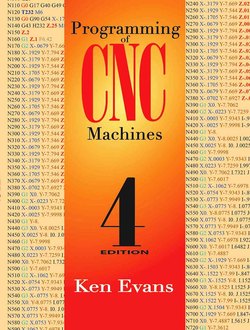Читать книгу Programming of CNC Machines - Ken Evans - Страница 8
На сайте Литреса книга снята с продажи.
ОглавлениеPreface
I am a full-time CNC Programmer at a prominent aerospace company and was formerly a Machine Tool Technology instructor at a local college with over 35 years of CNC operation, setup, and programming experience. My strong interest in the practical application of CNC is at the heart of this text; therefore, all theoretical explanations are kept to a minimum to facilitate an easy read and to promote a quick understanding of programming. Because of the wide range of information available in this text about the selection of tools, cutting speeds, and the technology of machining, I hope this book will reach a variety of readers. Included among these are: Pre-Engineering students, those already involved in programming or maintaining CNC machines, operators of conventional machines who may want to expand their knowledge beyond conventional machining, and, managers or other interested persons who may wish to purchase such machines in the near future. Finally, I hope anyone with an interest in learning about modern CNC machining methods will find the book to be beneficial.
In this fourth edition, you will notice many features that will improve your reading experience. Chapter objectives are listed at the beginning of each chapter, specific terminology is presented, and study questions are added at the end of each chapter to confirm understanding. Throughout the text, figure captions are added to aid clarity.
In the first chapter, the foundation is laid with CNC Basics that set the tone for successful programming. The second chapter on CNC Machine Operation gives the reader perspective about CNC operation and setup procedures, because the first exposure a machinist has to CNC is usually as an operator. Operators will not be concerned right away with programming. However, after some time, practice, and the confidence of the owner, operators are given greater responsibility, e.g. changing wear offsets, performing setups, and minor program editing. The first and second chapters emphasize the development of machine setup and program editing skills. Students, machinists, supervisors, and design and manufacturing engineers will benefit from these chapters by learning foundational skills associated with setup and operation of CNC machine tools, prior to programming.
Chapters 3 and 4 focus on the components and development of program code for CNC turning and machining centers, with over 50 programming examples.
Today CNC programming is completed mostly by use of Computer-Aided Design and Computer-Aided Manufacturing (CAD/CAM); the popularity of Conversational Programming at the machine controller is increasing. Two chapters are devoted to the subject in this edition. Chapter 5, the CAD/CAM chapter, has been updated to include the current version of Mastercam X8 software. Chapter 6 is a new chapter that has been added to introduce Feature-Based Machining using Siemens NX9.0 CAM.
A new Chapter 7 has been added to feature FANUC NC Guide i programming for the popular Oi control. Step-by-step examples are given for Turning and Machining Center programs.
Chapter 8, the Mazatrol™ Conversational Programming chapter, has been expanded to include programming examples and study questions. An example program is created using MazaCAM™ off-line programming software by SolutionWare. Many new machine tool controllers come standard with some form of Conversational Programming, two of which are presented in this text.
The appendix contains many useful charts, techniques, and math formulas used for line-by-line programming for user reference. The glossary of terms has been expanded to include more definitions.
The Student Workbook for Programming of CNC Machines, Fourth Edition, is also available from Industrial Press as a companion to the text to provide a complete CNC training curriculum.
The purpose of this book is to expand the reader’s current knowledge of CNC programming by providing full descriptions of all program functions and their practical applications. The book contains information on how to program turning and milling machines; this information is applicable to almost all control systems. The FANUC controller model is referenced here in order to provide clear explanations about one unified system. It is one of the most widely accepted, popular numerical control systems used worldwide.
Ken Evans, January 2016
